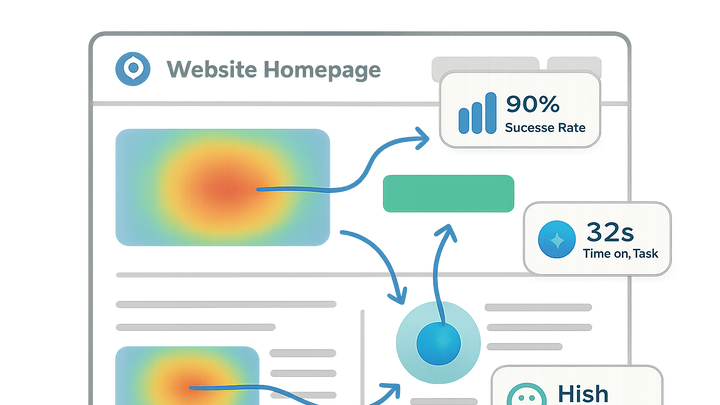Published on 2025-06-29T19:11:15Z
What Is User Experience (UX)? Impact on CRO, SEO, and Lead Generation
User Experience (UX) refers to the overall impression, emotions, and satisfaction a user has when interacting with a website. It encompasses every aspect of the user’s journey, from how easily they find information to how aesthetically pleasing and accessible the interface is. Good UX design removes friction, anticipates user needs, and guides visitors smoothly toward their goals, whether that’s making a purchase, signing up for a newsletter, or exploring content.
In the context of Conversion Rate Optimization (CRO) and Search Engine Optimization (SEO), UX is a critical factor: better UX leads to higher engagement, lower bounce rates, and improved search rankings. Conversely, a confusing or inaccessible site frustrates users, undermines credibility, and drives potential customers away. Tools like Prevue.me automate UX, CRO, SEO, and accessibility critiques, offering actionable insights to refine website experiences and maximize lead generation.
By focusing on UX, businesses not only delight users but also unlock tangible metrics improvements, making UX an essential investment for any website.
User experience (ux)
UX encompasses all aspects of a user's interaction with a website, guiding satisfaction, conversions, and SEO performance.
Definition and Scope of User Experience
This section defines UX and explains its scope within website optimization for CRO and SEO.
-
User experience defined
User Experience (UX) encompasses all aspects of a person’s interaction with a website, including usability, accessibility, and emotional response.
-
Ux vs ui
While UX focuses on overall satisfaction and ease of use, User Interface (UI) design is concerned with the visual and interactive elements of the site.
-
Ux in website optimization
In the context of CRO and SEO, UX improvements can lead to higher conversion rates and better search rankings by reducing friction and bounce rates.
Key Components of UX
Breakdown of fundamental elements that contribute to a positive UX.
-
Usability
The ease with which users can complete tasks, navigate the site, and find information quickly.
- Navigation:
Clear menus and logical site structure.
- Performance:
Fast load times and responsive interactions.
- Navigation:
-
Accessibility
Ensuring the website is usable by people with disabilities through inclusive design practices.
- Wcag compliance:
Adhering to Web Content Accessibility Guidelines.
- Assistive technologies:
Support for screen readers and keyboard navigation.
- Wcag compliance:
-
Information architecture
Organizing and structuring content so users can find information intuitively.
- Sitemaps:
Hierarchical organization of pages and sections.
- Content hierarchy:
Use of headings and labels to guide users.
- Sitemaps:
-
Visual design
The aesthetic elements that improve readability, brand consistency, and user engagement.
- Typography:
Legible fonts and appropriate sizes.
- Color scheme:
Accessible contrast and brand-aligned colors.
- Typography:
-
Interaction design
Design of interactive elements and feedback to engage users.
- Microinteractions:
Small animations or responses to user actions.
- Feedback mechanisms:
Notifications, tooltips, and error messages.
- Microinteractions:
Benefits of Optimizing UX
Explores how enhancing UX drives business outcomes like conversions, SEO improvements, and lead generation.
-
Increased conversions
Smooth user journeys encourage visitors to complete desired actions, boosting CRO.
-
Improved seo
Positive UX metrics like low bounce rates and high dwell time signal search engines to rank the site higher.
-
Enhanced lead generation
Clear calls-to-action and intuitive forms improve lead capture efficiency.
-
Stronger brand loyalty
Consistent and satisfying experiences encourage repeat visits and referrals.
Measuring and Improving UX with Prevue.me
Discusses practical approaches using tools like prevue.me to audit and refine UX.
-
Automated ux audits
Leverage prevue.me to receive actionable critiques on UX, CRO, SEO, and accessibility.
- Overview of prevue.me:
A SaaS platform offering targeted feedback to optimize user flows and increase leads.
- Key features:
Heatmaps, UX checklists, SEO insights, and CRO recommendations.
- Overview of prevue.me:
-
Incorporating feedback
Implement suggestions from prevue.me to iterate on design and improve user satisfaction.
- Prioritization:
Rank issues based on impact and implementation effort.
- A/b testing:
Validate changes using split tests to measure improvements.
- Prioritization:
-
Continuous monitoring
Set recurring audits in prevue.me to track UX improvements over time.
- Dashboard tracking:
Monitor key KPIs such as conversion rates and accessibility scores.
- Progress reports:
Receive regular reports to guide ongoing optimization.
- Dashboard tracking:
Best Practices for Sustained UX Excellence
Provides general guidelines for maintaining and evolving UX quality.
-
Adopt mobile-first design
Design for smaller screens first to ensure accessibility and performance on all devices.
-
Maintain consistent design language
Use uniform styles and components to reduce cognitive load and enhance brand identity.
-
Implement accessibility standards
Regularly audit for WCAG compliance and include diverse user testing scenarios.
-
Schedule regular ux reviews
Conduct periodic audits with tools like prevue.me and manual testing to identify new issues.
